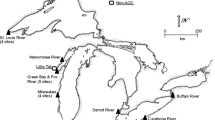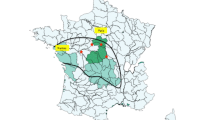Abstract
Osprey (Pandion haliaetus) eggs were collected in 14 states in 1970–79 and analyzed for organochlorine pesticides, polychlorinated biphenyls (PCBs), and mercury. Moderate shell thinning occurred in eggs from several areas. DDE was detected in all eggs, PCBs in 99%, DDD in 96%, dieldrin in 52%, and other compounds less frequently. Concentrations of DDT and its metabolites declined in eggs from Cape May County, New Jersey between 1970–72 and 1978–79. Eggs from New Jersey in the early 1970s contained the highest concentrations of DDE. Dieldrin concentrations declined in eggs from the Potomac River, Maryland during 1971–77. Five different contaminants were significantly negatively correlated with shell thickness; DDE was most closely correlated. Ten percent shell thinning was associated with 2.0 ppm DDE, 15% with 4.2 ppm, and 20% with 8.7 ppm in eggs collected from randomly selected nests before egg loss. Shell thickness could not be accurately predicted from DDE concentrations in eggs collected after failure to hatch, presumably because the eggs with the thinnest shells had been broken and were unavailable for sampling. DDE was also significantly negatively correlated with brood size. Other contaminants did not appear to adversely affect shell thickness or reproductive success.
Similar content being viewed by others
References
Abou-Donia MB, Menzel DB (1968) The metabolismin vivo of 1,1,1-trichloro-2,2-bis(p-chlorophenyl)ethane (DDT), 1,1-dichloro-2,2-bis(p-chlorophenyl)ethane (DDD), and 1,1-dichloro-2,2-bis(p-chlorophenyl)ethylene (DDE) in the chick by embryonic injection and dietary ingestion. Biochem Pharmacol 17:2143–2161
Ames PL (1966) DDT residues in the eggs of the osprey in the north-eastern United States and their relation to nesting success. J Appl Ecol 3(suppl):87–97
Ames PL, Mersereau GS (1964) Some factors in the decline of the osprey in Connecticut. Auk 81:173–185
Anderson DW, Hickey JJ (1972) Eggshell changes in certain North American birds. Proc Internat Ornithol Congr 15:514–540
— (1974) Eggshell changes in raptors from the Baltic region. Oikos 25:395–401
Blus LJ (1982) Further interpretation of the relation of organochlorine residues in brown pelican eggs to reproductive success. Environ Pollut 28A:15–33
— (1984) DDE in bird's eggs: comparisons of two methods for estimating critical levels. Wilson Bull 96:268–276
Blus LJ, Neely BS Jr, Lamont TG, Mulhern B (1977) Residues of organochlorines and heavy metals in tissues and eggs of brown pelicans, 1969–73. Pestic Monit J 11:40–53
Bogan JA, Newton I (1983) The effects of organochlorine compounds on British birds of prey. Vet Res Comm 7:119–124
Bunck CM, Spann JW, Pattee OH, Fleming WJ (1985) Changes in eggshell thickness during incubation: Implications for evaluating the impact of organochlorine contaminants on productivity. Bull Environ Contam Toxicol 35:173–182
Cade TJ, Lincer JL, White CM, Roseneau DG, Swartz LG (1971) DDE residues and eggshell changes in Alaskan falcons and hawks. Science 172:955–957
Cromartie E, Reichel WL, Locke LN, Belisle AA, Kaiser TE, Lamont TG, Mulhern BM, Prouty RM, Swineford DM (1975) Residues of organochlorine pesticides and polychlorinated biphenyls and autopsy data for bald eagles, 1971–72. Pestic Monit J 9:11–14
DeWeese LR, McEwen LC, Hensler GL, Petersen BE (1986) Organochlorine contamination in Passeriformes and other avian prey of the peregrine falcon in the western United States. Environ Toxicol Chem 5:675–693
Emerson D, Davenport M (1963) Profile of the osprey. Narragansett Nat 6:56–58
Enderson JH, Craig GR, Burnham BA, Berger DD (1982) Eggshell thinning and organochlorine residues in Rocky Mountain peregrines,Falco peregrinus, and their prey. Canad Field-Nat 96:255–264
Enderson JH, Wrege PH (1973) DDE residues and eggshell thickness in prairie falcons. J Wildl Manage 37:476–478
Findholt SL (1984) Organochlorine residues, eggshell thickness, and reproductive success of snowy egrets nesting in Idaho. Condor 86:163–169
Findholt SL, Trost CH (1985) Organochlorine pollutants, eggshell thickness, and reproductive success of black-crowned night-herons in Idaho, 1979. Colonial Waterbirds 8:32–41
Grier JW, Sindelar CR, Evans DL (1977) Reproduction and toxicants in Lake of the Woods ospreys. In: Ogden JC (ed) Transactions of the North American osprey research conference. USDI National Park Service Transactions and Proceedings Series No 2, pp 181–192
HÄkkinen I, HÄsÄnen E (1980) Mercury in eggs and nestlings of the osprey (Pandion haliaetus) in Finland and its bioaccu-mulation from fish. Ann Zool Fennici 17:131–139
Harman HH (1967) Modern factor analysis. University of Chicago Press, Chicago, 474 pp
Hatch WR, Ott WL (1968) Determination of sub-microgram quantities of mercury by atomic absorption spectrophotom-etry. Anal Chem 40:2085–2087
Heath RG, Spann JW, Kreitzer JF (1969) Marked DDE impairment of mallard reproduction in controlled studies. Nature 224:47–48
Henny CJ (1977) Research, management, and status of the osprey in North America. In: Chancellor RD (ed) World conference on birds of prey, International Council for Bird Preservation, pp 199–222
Henny CJ, Blus LJ (1986) Radiotelemetry locates wintering grounds of DDE-contaminated black-crowned night-herons. Wildl Soc Bull 14:236–241
Henny CJ, Blus LJ, Krynitsky AJ, Bunck CM (1984) Current impact of DDE on black-crowned night-herons in the Intermountain West. J Wildl Manage 48:1–13
Henny CJ, Blus LJ, Stafford CJ (1983) Effects of heptachlor on American kestrels in the Columbia Basin, Oregon. J Wildl Manage 47:1080–1087
Henny CJ, Byrd MA, Jacobs JA, McLain PD, Todd MR, Halla BF (1977) Mid-Atlantic coast osprey population: Present numbers, productivity, pollutant contamination, and status. J Wildl Manage 41:254–265
Hickey JJ, Anderson DW (1968) Chlorinated hydrocarbons and eggshell changes in raptorial and fish-eating birds. Science 162:271–273
Johnson DR, Melquist WE, Schroeder GJ (1975) DDT and PCB levels in Lake Coeur d'Alene, Idaho, osprey eggs. Bull Environ Contam Toxicol 13:401–405
Johnson LD, Waltz RH, Ussary JP, Kaiser FE (1976) Automated gel permeation chromatographic cleanup of animal and plant extracts for pesticide residue determination. J Assoc Offic Anal Chem 59:174–187
Kaiser TE, Reichel WL, Locke LN, Cromartie E, Krynitsky AJ, Lamont TG, Mulhern BM, Prouty RM, Stafford CJ, Swineford DM (1980) Organochlorine pesticide, PCB, and PBB residues and necropsy data for bald eagles from 29 States—1975–77. Pestic Monit J 13:145–149
Koivusaari J, Nuuja I, Palokangas R, Vihko V (1972) Decrease in eggshell thickness of the wite-tailed eagle in Finland during 1884–1971. Ornis Fennica 49:11–13
Kreitzer JF (1972) The effect of embryonic development on the thickness of egg shells of Coturnix quail. Poultry Sci 51:1764–1765
Lincer JL (1972) The effects of organochlorines on the American kestrel (Falco sparverius Linn.). Doctoral Dissertation, Cornell University, Ithaca, New York
Littrell EE (1986) Shell thickness and organochlorine pesticides in osprey eggs from Eagle Lake, California. Calif Fish Game 72:182–185
MacCarter DL, MacCarter DS (1979) Ten-year nesting status of ospreys at Flathead Lake, Montana. Murrelet 60:42–49
Mallas J, Benedicto N (1986) Mercury and goldmining in the Brazilian Amazon. Ambio 15:248–249
Mendenhall VM, Klaas EE, McLane MAR (1983) Breeding success of barn owls (Tyto alba) fed low levels of DDE and dieldrin. Arch Environ Contam Toxicol 12:235–240
Monk HE (1961) Recommended methods of analysis of pesticide residues in food stuffs. Report by the Joint Mercury Residues Panel. Analyst 86:608–614
Moriarty F, Bell AA, Hanson H (1986) Doesp,p′-DDE thin eggshells? Environ Pollut 40A:257–286
Morrison DF (1976) Multivariate statistical methods, 2nd edn. McGraw-Hill, New York, 415 pp
Neter J, Wasserman W (1974) Applied linear statistical models. Richard D. Irwin, Inc, Homewood, Illinois, 842 pp
Newton I, Bogan J (1974) Organochlorine residues, eggshell thinning and hatching success in British sparrowhawks. Nature 249:582–583
Newton I, Bogan J, Meek E, Little B (1982) Organochlorine compounds and shell-thinning in British merlinsFalco columbarius. Ibis 124:328–335
Newton I, Bogan JA, Rothery P (1986) Trends and effects of organochlorine compounds in sparrowhawk eggs. J Appl Ecol 23:461–478
Odsjo T (1971) Klorerade kolvaten och aggskalsfortunning hos fiskgjuse. Fauna Och Flora 66:90–100
Ogden JC (ed) (1977) Transactions of the North American osprey research conference. USDI National Park Service, Transactions and Proceedings Series No 2, 258 pp
Peakall DB, Cade TJ, White CM, Haugh JR (1975) Organochlorine residues in Alaskan peregrines. Pestic Monit J 8:255–260
Peterson RT (1969) Population trends of ospreys in the northeastern United States. In: Hickey JJ (ed) Peregrine falcon populations their biology and decline. University of Wisconsin Press, Madison, pp 333–337
Poole AF, Agler B (1987) Recoveries of ospreys banded in the United States, 1914–84. J Wildl Manage 51:148–155
Postupalsky S (1969) The status of the osprey in Michigan in 1965. In: Hickey JJ (ed) Peregrine falcon populations their biology and decline. University of Wisconsin Press, Madison, pp 338–340
-(1977) Status of the osprey in Michigan. In: Ogden JC (ed) Transactions of the North American osprey research conference. USDI National Park Service Transactions and Proceedings Series No 2, pp 153–165
Ratcliffe DA (1970) Changes attributable to pesticides in egg breakage frequency and eggshell thickness in some British birds. J Appl Ecol 7:67–115
Reese JG (1977) Reproductive success of ospreys in central Chesapeake Bay. Auk 94:202–221
— (1981) Osprey reproductive success along Choptank River, Maryland. Estuaries 4:369–373
Schmid FC (1966) The status of the osprey in Cape May County, New Jersey between 1939 and 1963. Chesapeake Sci 7:220–223
Spitzer PR, Poole AF, Scheibel M (1983) Initial population recovery of breeding ospreys in the region between New York City and Boston. In: Bird DM, Seymour NR, Gerrard JM (eds) Biology and management of bald eagles and ospreys. Harpell Press, Ste. Anne de Bellevue, Quebec, Canada, pp 231–241
Spitzer PR, Risebrough RW, Grier JW, Sindelar CR Jr (1977) Eggshell thickness-pollutant relationships among North American ospreys. In: Ogden JC (ed) Transactions of the North American osprey research conference. USDI National Park Service Transactions and Proceedings Series No 2, pp 13–19
Spitzer PR, Risebrough RW, Walker W II, Hernandez R, Poole A, Puleston D, Nisbet ICT (1978) Productivity of ospreys in Connecticut-Long Island increases as DDE residues decline. Science 202:333–335
Stafford CJ, Reichel WL, Swineford DM, Prouty RM, Gay ML (1978) Gas-liquid chromatographic determination of kepone in field-collected avian tissues and eggs. J Assoc Offic Anal Chem 61:8–14
Stickel LF, Chura NJ, Stewart PA, Menzie CM, Prouty RM, Reichel WL (1966) Bald eagle pesticide relations. Trans No Amer Wildl Natural Resources Conf 31:190–200
Stickel LF, Wiemeyer SN, Blus LJ (1973) Pesticide residues in eggs of wild birds: Adjustment for loss of moisture and lipid. Bull Environ Contam Toxicol 9:193–196
Walker CH, Jefferies DJ (1978) The postmortem reductive dechlorination ofpp′DDT in avian tissues. Pestic Biochem Physiol 9:203–210
Whittemore RE (1984) Historical overview of osprey at the Mattamuskeet National Wildlife Refuge: results from ten years of nest and productivity surveys. In: Westall MA (ed) Proceedings of the southeastern U.S. and Caribbean osprey symposium. The International Osprey Foundation, Inc, Sanibel Island, Florida, pp 17–41
Wiemeyer SN (1971) Reproductive success of Potomac River ospreys — 1970. Chesapeake Sci 12:278–280
-(1977) Reproductive success of Potomac River ospreys, 1971. In: Ogden JC (ed) Transactions of the North American osprey research conference. USDI National Park Service Transactions and Proceedings Series No 2, pp 115–119
Wiemeyer SN, Lamont TG, Bunck CM, Sindelar CR, Gramlich FJ, Fraser JD, Byrd MA (1984) Organochlorine pesticide, polychlorobiphenyl, and mercury residues in bald eagle eggs—1969–79—and their relationships to shell thinning and reproduction. Arch Environ Contam Toxicol 13:529–549
Wiemeyer SN, Lamont TG, Locke LN (1980) Residues of environmental pollutants and necropsy data for eastern United States ospreys, 1964–1973. Estuaries 3:155–167
Wiemeyer SN, Spitzer PR, Krantz WC, Lamont TG, Cromartie E (1975) Effects of environmental pollutants on Connecticut and Maryland ospreys. J Wildl Manage 39:124–139
Wiemeyer SN, Schmeling SK, Anderson A (1987) Environmental pollutant and necropsy data for ospreys from the eastern United States, 1975–1982. J Wildl Diseases 23:279–291
Wiemeyer SN, Swineford DM, Spitzer PR, McLain PD (1978) Organochlorine residues in New Jersey osprey eggs. Bull Environ Contam Toxicol 19:56–63
Author information
Authors and Affiliations
Rights and permissions
About this article
Cite this article
Wiemeyer, S.N., Bunck, C.M. & Krynitsky, A.J. Organochlorine pesticides, polychlorinated biphenyls, and mercury in osprey eggs — 1970–79 — and their relationships to shell thinning and productivity. Arch. Environ. Contam. Toxicol. 17, 767–787 (1988). https://doi.org/10.1007/BF01061982
Received:
Revised:
Issue Date:
DOI: https://doi.org/10.1007/BF01061982




